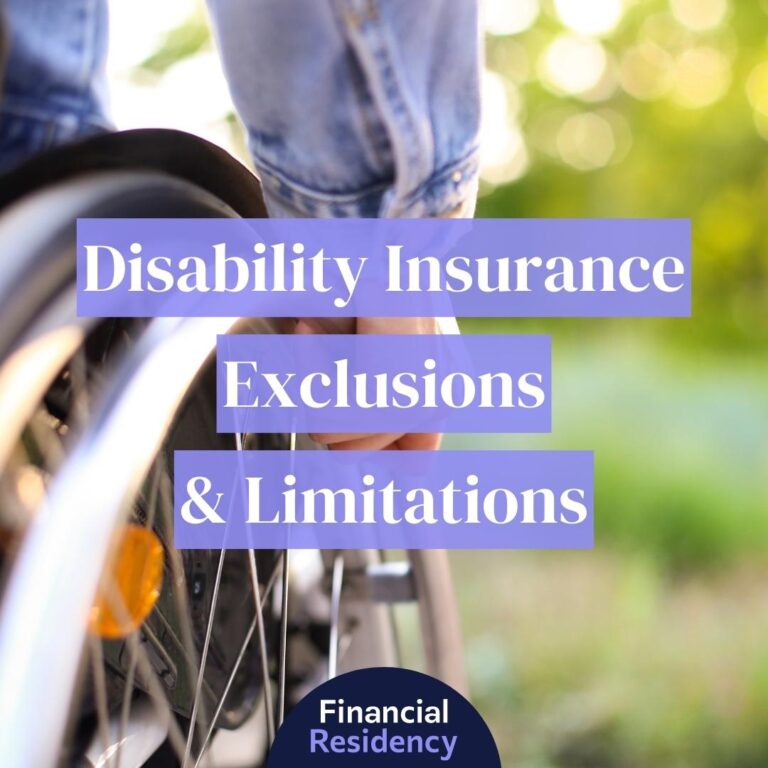Protecting your income is one of the most critical steps to take when you start your career.
Carrying one short-term disability policy may leave you with gaps in coverage, but stacking policies may help you get the benefits you need at affordable prices.
Can You Have Two Short-Term Disability Insurance Policies?
Yes! You can purchase multiple short-term disability insurance policies to supplement your income.
Many doctors can have two (or more) short-term disability policies, but each policy has different rules and limits to consider and review carefully.
The most crucial factor to consider is the total maximum monthly benefit allowed, which means the total amount earned from all insurance policies, not just a single policy.
For example, if you have a policy that pays a monthly cap of $10,000, but you make $25,000 a month, you won’t be able to survive on $10,000 alone. That’s less than 50% of your regular monthly income.
As you dig further into the policy’s requirements, you discover they allow a maximum combined monthly benefit of $25,000. You’d be covered if you could find another short-term policy for $15,000 a month.
Learn More:
Why Stack Short-Term DI Policies?
You might wonder why you’d stack short-term disability policies. Wouldn’t it be easier and possibly cheaper to purchase one policy?
There are several reasons to explore.
Income Increase
Many residents purchase disability insurance immediately. It’s a smart move, not only to protect your investment in your medical career but also to secure the lowest premiums. Like most insurance, such as health and life insurance, you may get lower rates if you secure the insurance when you’re young and healthy.
But what happens when your income increases two or even three times as much as your original salary?
For example, you buy a policy with a $5,000 monthly cap benefit. If you make $60,000 to $75,000 a year, the $5,000 limit may suffice.
However, your income increases to $150,000 a year or $12,500 a month in a few years.
Chances are $5,000 a month won’t be enough if you become disabled.
You Have Two Options in this Situation:
- Cancel your current policy: You can cancel your current policy and buy a new one. However, doing so means higher premiums not only because you need more coverage but also because you’re older.
- Keep your current policy and supplement: You could keep your original policy with the lower premiums and supplement with an additional policy to make up the difference. You get to keep the lower premiums and pay less on a new policy because you don’t need as much coverage.
Monthly Benefit Increase
If you purchased a disability insurance policy for a lower maximum benefit than you would need because it’s all you could afford, you might consider supplementing.
Before choosing this option, read the fine print and know the total maximum monthly benefit allowed. Then, if you haven’t surpassed the limit, you can look for another policy that will supplement the current policy, getting you closer to the amount you’d need if you became disabled.
Stack Elimination Periods
The elimination period is how long you must wait before the insurance company pays benefits. Of course, the longer the elimination period, the lower the premiums you’ll pay, but being without benefits can be difficult.
To make the most of your disability benefits, you can have one policy with a longer elimination period than the other. The policy with the longer elimination period will have lower premiums, and the shorter one will cost more.
Combining the two can help you supplement your income while initially disabled. You’ll receive benefits from the policy with a short elimination period initially, and it can supplement your income until the policy with greater benefits and a longer elimination period begins.
This works best for people with enough money saved to supplement the lower income during the elimination period.
Increased Access to More Riders and Features
You may find that you are unable to find the ‘perfect’ disability policy. For example, one might have a rider you want but not enough monthly coverage, while another may offer coverage but not enough riders.
You can create the ‘perfect situation’ by stacking disability policies.
Some riders to consider include:
- COLA
- Catastrophic disability
- Residual disability
- Student loan rider
How Stacking Disability Insurance Policies Work
Stacking disability insurance works the same as if you only had one policy. You file your claim with each company immediately and follow their guidelines.
If you have a policy with a longer elimination period, for example, you won’t receive benefits right away, but you’ll have the disability documented and a claim filed. Each policy limits the monthly amount you can receive, so abide by the rules.
Typically when you stack disability policies, they have different coverage terms, payouts, and riders. Take advantage of each rider that applies, and stack the policies so you get the most out of each when you need them.
Cost vs. Coverage
When deciding if you should stack disability policies, compare the cost of the policies combined and the coverage you receive.
For example, getting more coverage using two policies and paying lower premiums than one large policy may be worth it.
Sometimes, it’s even worth it if the coverage is the same with the combined policies, but you can create the ‘perfect policy’ with the riders and features you need.
Stacking policies can help you create the policy that suits your needs, but be mindful that what you are getting is worth the cost you are putting in.
Stacking vs. Supplemental Coverage
Supplemental coverage is another form of disability coverage, but as the name suggests, it’s strictly to supplement your primary policy.
For example, if you have a long-term disability policy with a six-month elimination period, you might not be able to get through those six months without coverage.
So instead, you can supplement or bridge the gap with a supplemental policy with a short-term but little to no elimination period. This ensures you’ll have a payout immediately but won’t lose your long-term disability with the lower premiums you already own.
Stacking coverage allows you to customize your policy to the greatest extent. It’s similar to supplementing because you can stagger elimination and payout periods, but you can also stack policies with different benefits that maximize how much you earn in different situations.
Which Is Better – Stacking or Supplementing?
There isn’t a one-size-fits-all answer for stacking vs. supplementing. The correct answer for you depends on your situation. For example, suppose you have a long-term disability policy with enough coverage and low premiums.
In that case, you probably don’t want to lose it, so you should supplement if you need something with a shorter elimination period.
However, if you haven’t purchased a policy yet and want to keep your costs low while getting the ideal policy, stacking can help you customize your coverage, helping you cover all bases in protecting your income.
FAQs
Having two or more disability insurance policies can be complex, but it can help you get the coverage you need. Check out these frequently asked questions about stacking short-term policies.
How Much Short-Term Disability Insurance Should I Get?
Ideally, you should cover 60% of your income. It might not sound like enough, but if the benefits are tax-free, you’ll be close to your net income from your career. Plus, your expenses may be lower if you cannot work. For example, your commuting, clothing, or food expenses may not be as high.
Is There a Cap to How Many Policies I Can Have?
You can have as many short-term disability policies as you want; however, each policy has a maximum payout you can receive from all policies combined. The total you receive cannot exceed the limit for any policy.
Keep this in mind when purchasing policies so you aren’t investing in coverage that you can’t utilize.
What Is the Max Duration of a Short-Term Disability Policy?
The longest duration for a short-term disability policy is 12 months, but some are as short as a few months. If you are unable to return to work after 12 months, your long-term disability insurance will kick in (if you have it), or you may become eligible for Social Security Disability Insurance benefits.
The Bottom Line
Two short-term disability insurance policies can help you receive the maximum coverage with desired features. You can control the costs, when you receive benefits, and for how long, creating the perfect situation should you become disabled.
Evaluating the best short-term disability strategy for you may be tricky; there are a lot of details to consider.
Don’t hesitate to speak to a financial advisor or your insurance provider to help you navigate the finer details of your policy.



